 By Pepper Parr
By Pepper Parr
June 13th, 2022
BURLINGTON, ON
Dan VanderLelie, President, Burlington Professional Firefighters Association, IAFF Local 1552 and Director Zone 3, Ontario Professional Fire Fighters Association, is an Acting Platoon Chief in the Burlington Fire department. He delegated to city coumcil last week.
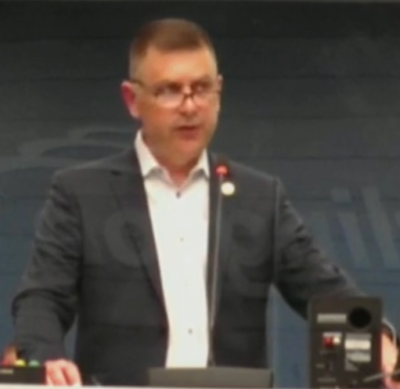
Dan VanderLelie, President, Burlington Professional Firefighters Association, IAFF Local 1552 and Director Zone 3, Ontario Professional Fire Fighters Association.
It was one of the lengthier and drill down deep delegations this writer has ever heard in Burlington . Dan was before Council for more than an hour.
As head of the Fireman’s union it has been suggested that he puts the interests of the union members before the public interest. Our experience with Dan, covers a period of ten years and in that time I have come to the conclusion that Dan is very concerned about public safety and the safety of the men and women who fight fires. He does argue that if the firefighters are not properly taken care of – you don’t have an effective fire department
Here is what else VanderLelie had to say:
When responding to fires in high rise buildings, firefighting crews of four to five members instead of two or three are significantly faster in putting out fires and completing search and rescue operations. The Fire Department Master Plan report (which was also discussed at Council on the same day) made it clear that the Burlington Fire Department is not currently able to assemble the fire fighting teams that are needed to fight high rise situations.
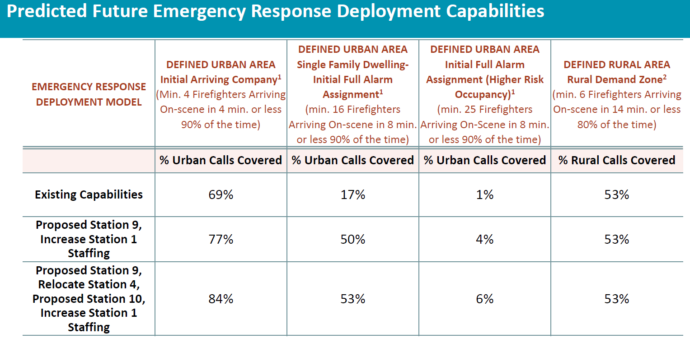
What the city has and what it is going to need in terms of equipment and staff -including two new fire stations.
The minimum required is 39 firefighters at the location within 10 minutes and 10 seconds. It has to be noted that the department currently only deploys 35 firefighters per shift which includes a platoon chief
VanderLelie adds that one high rise fire will pull multiple resources from different parts of the city – which doesn’t leave much to answer another fire call in the same time period.
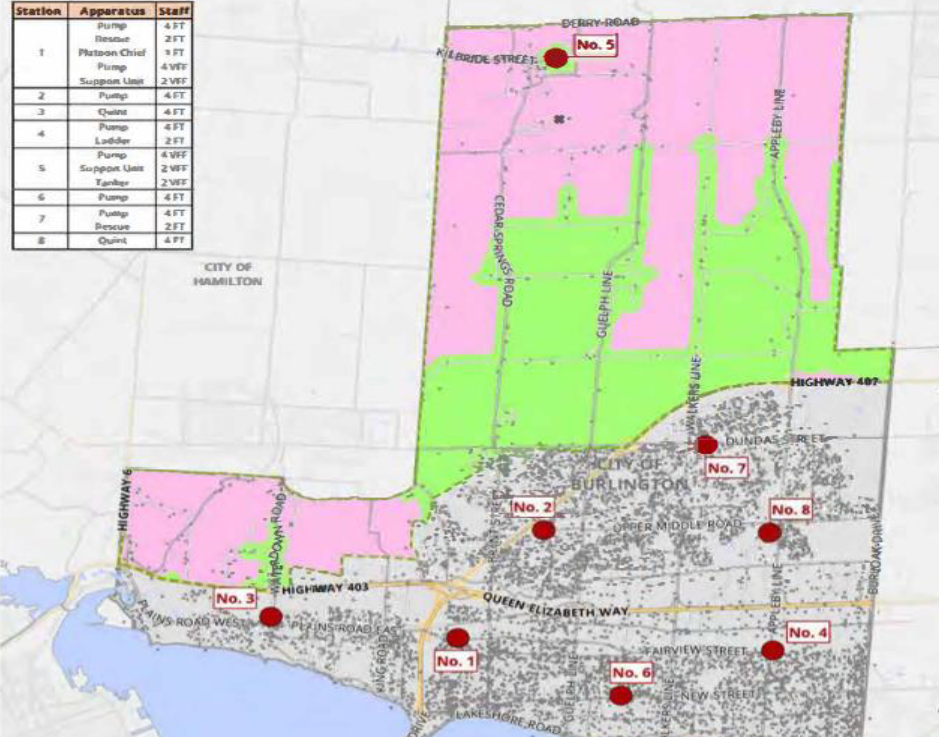
This graphic shows where the current fire departments are located and what each has in the way of equipment.. When there is a major fire that requires a lot of equipment the dispatch people will move equipment around so that there is the kind of coverage needed on an hour by hour basis.
The Burlington fire department should add resources to the waterfront downtown area, which contains many high rise high rises and large future developments. Building a station nine (which would be a new station) and stuffing it with a truck with four firefighters provides better coverage for the downtown core.
Increasing ladder 342 (which is a fire fighting unit – not a piece of equipment) with a daily minimum staffing of four would allow for more efficient deployment of aerial apparatus and protect existing and proposed high rise structures and occupants.
Increasing daily minimum staffing on rescue 312 and 372 (these are also units) will allow for timely assembly of effective response force. This will better protect the citizens structures and firefighters. The purpose of the National Firefighting Professional Association (NFPA) 1710 standard is to specify the minimum criteria addressing the effectiveness and efficiency of the Career (as opposed to volunteer) public fire suppression operations, emergency medical service and special operations delivery and protecting the citizens of the jurisdiction and the occupational safety and health of the fire department employees.
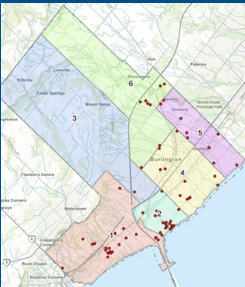
Each red dot is a development application that is working its way through the approval process.
So I don’t want to say imagine this because you already aware of the intensification and density we are faced with in the very near future. When we requested the IAFF International Association of Firefighters do a GIS study for us which you all received a copy of – they were astonished at the speed and rate of the vertical growth in the city.
Their report discussed the development expected to take place and the need for additional fire station space and equipment in station 3’s and and more on station 1’s area. They were shocked at how quickly and how high we are going.
The intensification and vertical growth will create increased traffic congestion. It will also create longer emergency contact times whether it be for medical rescue or a fire. It must also be pointed out that this creates response time concerns for all of the other occurrences that we run within the city.
Our city has seen tremendous growth over the past 11 years, whether it be up in whether it be out and during that time our fire service has been stagnant. There has been no increase in staffing or deployment options. We’ve had zero growth. We’ve been asked to do more with the same or less – this model in practice cannot continue.
The fire chief made a presentation to you a couple of weeks ago regarding our staffing levels. I’m asking that the immediate needs to be addressed and met by this council and further requests be included in the 2023 budget.
That was the end of the VanderLelie delegation. The questions from members of Council began; it took the Acting Platoon Chief an hour to answer them all
After his formal delegation he was asked by Ward 2 Councillor Lisa Kearns what was involved in fighting fires in high rise towers – buildings in the 30 floor plus range. Kearns: asked: can you explain the word high rise tome? And can you explain what a high rise response involves? And can you give us a better understanding of the resources required?
I’ll also ask you to weave in some conversations around what is a tall building? What is a high rise? I’m not quite sure recalling those two things, the same thing from a planning perspective and from a response perspective.

This is what is required in the way of a medium response force.
Dan: Okay. So if I may, I’m going to walk you through some of the the issues that we’re faced with including what a response looks like. And we’ll count through some of the individuals that respond.
So high rise fires are extremely labour intensive for us. There’s many factors that add so much complexity to it, Vertical Response – having to get to the floor. We talked about four minutes getting to the building – we could have up to two minutes in a vertical response if we’re in elevators. If we can’t take elevators we got to take stairs and therefore adding more time understanding that time means more fire growth. Fire conditions are amplified if, let’s say in the in the unit where the fire is, if the windows blow out. Obviously feeding more wind, wind driven fires, are extremely dangerous for firefighters.
The top of the list is the residents – we can have upwards of 400 residents in a building. So when you start factoring in the fire and the smoke migration to the other floors, which means more time and more taxing on the firefighters.
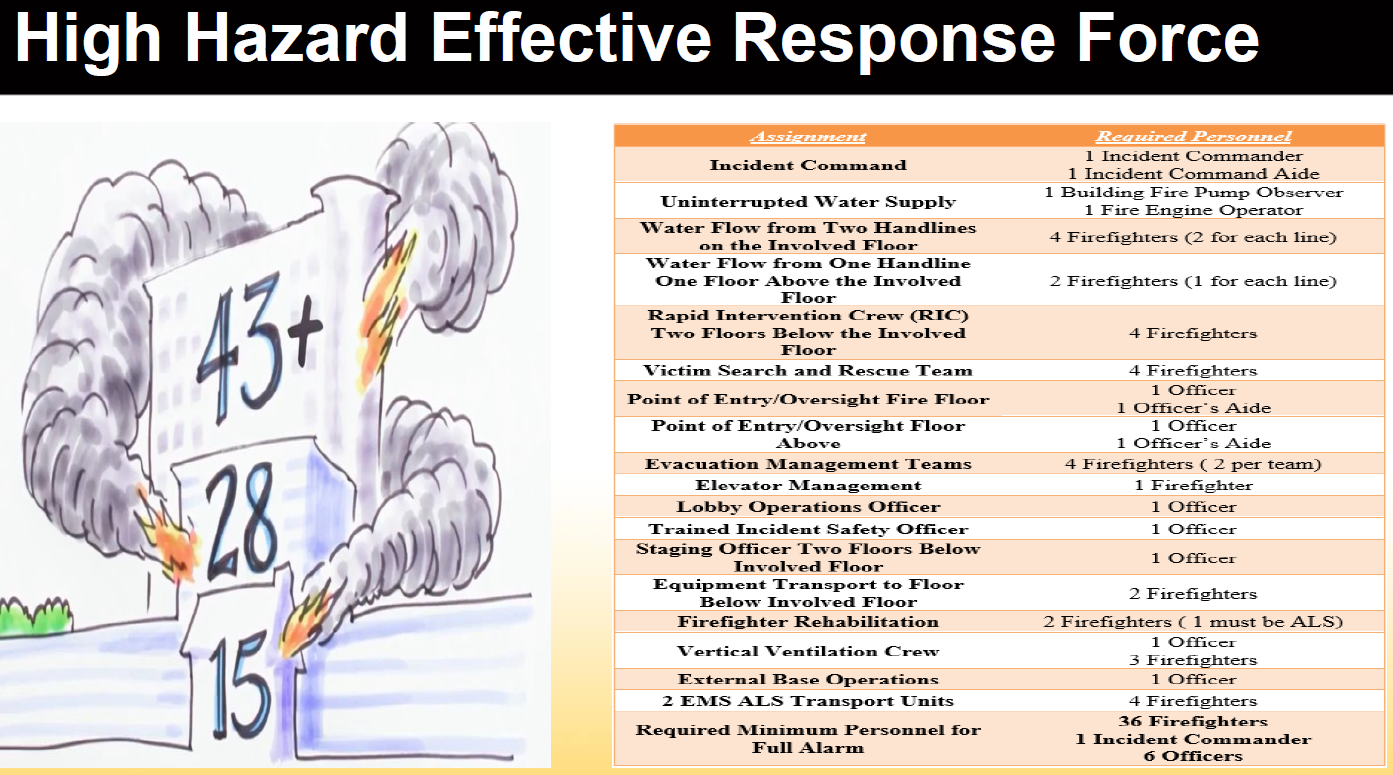
The manpower and equipment demands increase wit the height of the building.
These apartments are concrete. They’re ovens. They are concrete boxes, just radiating heat inside. Extreme heat makes things difficult.
I will use an apartment building with say 20 stories on Maple Crossing Boulevard. The first primary truck and when I say primary I mean a pump rescue which has four firefighters on it. When I say rescue, that’s two firefighters. A ladder truck is two firefighters. With the first primary truck on scene they will do an evaluation of what they have and report that back to dispatch and do a size up.
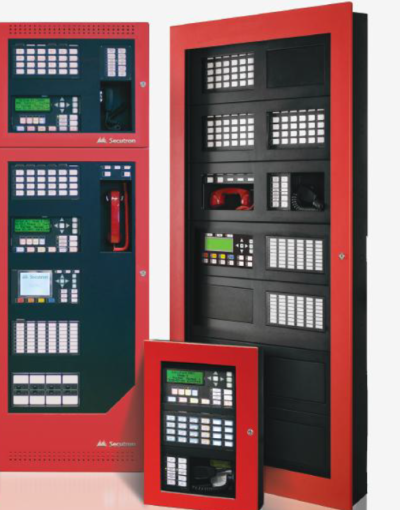
The annunciator panel is almost a map to the building with real time data essential to the firefighters who need to know what is happening where.
They firefighters will have made their way to the lobby. They’ll broadcast an initial report to our dispatch as to what they see on the annunciator panels and verify the incident location.
Every building has a panel that displays information – which floor a fire is on – which unit the fire is taking place in and determine if the building is equipped with a Chubb box, which is that little silver box which only firefighters have access to – it holds all the keys necessary to access every space in the building.
They open up the box pull out the appropriate keys they need; be it an elevator master key or a master key for the building.
They then move to take control of all the elevators and bring them to the ground floor. Then find the superintendent to gather as much information as we can.
That crew will then begin to initiate search and rescue operations and attempt confinement and extinguishment. The driver of the vehicle will be left with the elevator to operate the elevator. That’s if we can use the elevator. If we can’t use the elevator then we’ll take the driver with us. walking up the stairs
The firefighters will climb to one of two floors below the incident floor and that will be designated as incident control for our crews.
Then, as we are preparing we’re looking at what’s happening on that floor. The layout of the of the cabinets, the layout of where the elevator is the stairwells, the door numbering so then we’ll proceed to the operation stairwell and standby the standpipe connection.
We need two firefighters to hook up the standpipe, these are the pipes that carry the water to each floor – but we’ve only got one that can do it because the other two need to assist the captain going to the fire floor to begin rescue operations. So the crew will connect the high rise pack to the appliances in the standpipe and then we’ll begin to make our way down the hall into the onto the fire floor to the unit in question for fire containment, extinguishment or other measures that may be needed to mitigate the situation.

A team of firefighters carrying high rise packs of hose and an oxygen tank preparing to ascend a stairwell.
These crews will have with them so obviously their full PPE or personal protective equipment, their breathing apparatus, their hand lamps or portable radios. If we have a truck phone, we’ll take that with us. The high rise apartment packs, which is pretty much taking the truck up to the floor. So we have hoses, forcible entry tools, thermal imaging camera and other equipment that’s required.
So that’s the first truck. The second truck is going to arrive and they’re going to they’re going to support rescue operations as best as they can. So the second primary that arrives, they’re going to make their way to the incident control for and they’re going to set up a RAT team. The RAT team – rapid intervention team is there to protect the fire fighters.. If a firefighter goes down or firefighter needs rescue, that rapid intervention team is used for that so they bring all of their equipment. So that’s two guys off of that four man truck.
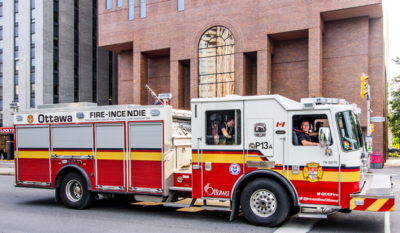
A pumper truck that will push water up through hoses and standpipes to get water to each level.
Then we need a second hose line. Realistically we need two people to take that second hose line. We’re only going to get one because of the people that we have there. And then the captain is going to act as a support role and an on deck role on that for so now we’ve got eight firefighters on scene eight firefighters on scene.
A third primary truck is in charge of water supply – locate a hydrant and then when you walk up to an apartment or the CFTC which means fire department connection, you see those brass fittings that stick out the side of the wall of the of the apartment those are we’re going to use those are the that’s FTC. That truck is tasked with water supply so they’re going to hook into the they’re going to use the crew that they have there to hook into that. And then once that’s hooked up, the driver remains with the truck. Those other three firefighters report to the incident control floor as more support.
The fourth primary that now shows up will report to the incident control for this out of all the trucks is one of the trucks that’s tasked with the most. The officer will be the incident safety officer will also be the could be the incident command for officer to have their people will formulate the RAT team which to set up an accountability board and know how to maintain accountability of all the firefighters that are involved in fire suppression operations or any firefighters that are on air on scene.
On air means those firefighters using oxygen. The rescue that showed up more than likely with the first primary they’ll still be in the lobby. They’ll be running lobby control and an accountability board in the lobby as well.
That accountability board tells the command people where every fire fighter is, how much oxygen they have left in their tanks if they are on air.

There are limits to just how high a ladder truck can rise.
The ladder when it shows up, will have two firefighters on will be charged with setting up aerial operations if required. They will be responsible for assisting and pressurizing of the stairwells with ventilation fans. They’ll provide ventilation through the through the roof, and they’ll also provide air monitoring.
Now a lot of the time what with all of this and all of these individuals that are working we haven’t factored in whether or not we find the victim yet whether or not we’ve had smoke migration or fire migration to another floor. We saw this in Toronto. I can’t remember the street but we saw in Toronto a few years back. The fire licked its way up and made its way to the next balcony.
At this point we have 20 people on scene with a Platoon Chief who is going to Command operations and move our resources.
With 20 or more on site it is more than likely that there will be a secondary call for a secondary unit to assist us with response. When we put all that together, the city has all those trucks – four of them – three primaries remaining with 12 firefighters and one rescue so we have 14 firefighters remaining in the city.
Like I said more than likely upgrading that department fire so now we’re going to have three trucks.
Dan VanderLelie was nearing the end of his explanation – added that it has been said before that while one fire is being battled there will always be another somewhere else that requires firefighters and resources .
And to meet those other fire calls the department needs both firefighters and equipment.
So, it’s been said before it’ll never happen, but every time we say it will never happen. It always happens.
Sorry. I should have told you it was going to be long.


















Helicopters anyone?
DeeDee Davies, I believe in an earlier article it was said a ladder can get to the 10th floor..
Eleanor Bain, Bless you. Have you been away for the past three years? The City has been fighting a losing battle against developers (backed up by the OLT and Doug Ford). Nobody wants the super high rises now being built and on the chocks to be built. Not council. Not residents.
Penny Hersh, have you ever had a positive word to say about anything?
Likely if Council was to approve spending to bring the brigade up to manpower and equipment levels requested by the fire department and not spend on Tech, and the City was to suffer a ransonware attach, you would howell that money should have been spent on Tech to prevent such attacks.
“ The intensification and vertical growth will create increased traffic congestion.”
And yet all the traffic reports submitted (and paid for) by developers with their applications continually say otherwise. Go figure.
Thank you for sharing this information. I wonder how many people consider this when thinking of purchasing or renting in a high rise. The article did not mention to what floor a ladder can reach. Certainly that would be a consideration for me.
Unfortunatly I had these thoughts before they even began building the high rises on the Lakeshore. What if there was a fire? I knew we were not equipped for such gigantic tall buildings to stop fires that high. I pray there are no fires for the peope whom are already living in these buildings. Our City Hall should think of safety first before agreeing or not even voting for such high buildings
This was many people’s concern also. Totally foreseeable. Do the insurance rates increase for those who live in the upper reaches of a high rise?
Not enough planning or thought going into resources. Fire fighting, future life of current landfill operations, electrical grid, how downtown traffic jams will affect the citizens and emergency services (at times there is no where to pull over too). Can the existing water supply, sewer and storm sewers handle the increased loads?
No. Insurance rates are not affected by floor level.
Infrastructure when inadequate to manage the growth is the responsibility of the municipality to get it to a place where it can handle the increased capacity. So yeah, the developers create the infrastructure strains and issues, but it is the municipality taxpayer that has to foot the bill to provide the infrastructure.
It’s not just a matter of a lack of thought or planning. A lack of financial wherewithal is the major issue. People question why services are not capable of handling the strain. The reason is simple. People complain about paying more in property taxes, and yet want first class services. One does not come without the other.
According to our city manager Tim Commisso money should be spent on Tech at this time and not on upgrading the fire services in our city.
As a matter of fact it was mentioned that the city manager did not want “operations” discussed at the council meeting even though the councillors wanted this information.
When should the money be spent – after a catastrophe?